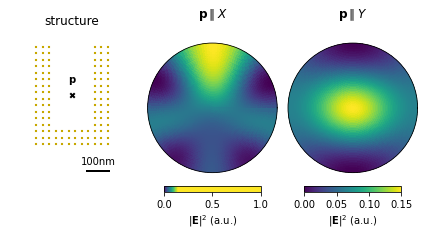Dipolar emitter coupled to gold split-ring resonator¶
01/2021: updated to pyGDM v1.1+
In this example, we try to obtain the results reported by Hancu et. al [1]: The scattering from a dipolar emitter, coupled to a gold split-ring resonator, becomes highly directional.
[1] Hancu, I. M. et al. Multipolar Interference for Directed Light Emission. Nano Lett. 14, 166–171 (2014) (http://dx.doi.org/10.1021/nl403681g)
[1]:
from pyGDM2 import structures
from pyGDM2 import materials
from pyGDM2 import fields
from pyGDM2 import core
from pyGDM2 import propagators
from pyGDM2 import linear
from pyGDM2 import tools
from pyGDM2 import visu
import numpy as np
import matplotlib.pyplot as plt
Simulation setup¶
Again, we setup the simulation. This time we will not use a plane wave, but rather a dipolar emitter as light source. The dipole will be placed in the center of the split-ring resonator and we will compare two orientations of the dipole (along X and along Y).
[2]:
## --- structure and envorinment
mesh = 'cube'
step = 30.0
geometry = structures.rect_split_ring(step, L1=12,L2=16,H=3,W=3, G=False, mesh=mesh)
material = materials.gold()
geometry = structures.center_struct(geometry)
struct = structures.struct(step, geometry, material)
## --- environment (vacuum)
dyads = propagators.DyadsQuasistatic123(n1=1, n2=1)
## --- incident field: dipolar emitter
field_generator = fields.dipole_electric # light-source: dipolar emitter
kwargs = dict(x0=0, y0=0, z0=1.5*step,
mx=[1,0], my=[0,1], mz=0)
wavelengths = [1000.]
efield = fields.efield(field_generator, wavelengths=wavelengths, kwargs=kwargs)
## --- Simulation object
sim = core.simulation(struct, efield, dyads)
## --- print a summary
tools.print_sim_info(sim, verbose=1)
structure initialization - automatic mesh detection: cube
structure initialization - consistency check: 342/342 dipoles valid
=============== GDM Simulation Information ===============
precision: <class 'numpy.float32'> / <class 'numpy.complex64'>
------ nano-object -------
Homogeneous object.
material: "Gold, Johnson/Christy"
mesh type: cubic
nominal stepsize: 30.0nm
nr. of meshpoints: 342
----- incident field -----
field generator: "dipole_electric"
1 wavelengths between 1000.0 and 1000.0nm
- 0: 1000.0nm
4 incident field configurations per wavelength
- 0: 'mx': 1, 'my': 0, 'mz': 0, 'x0': 0, 'y0': 0, 'z0': 45.0
- 1: 'mx': 1, 'my': 1, 'mz': 0, 'x0': 0, 'y0': 0, 'z0': 45.0
- 2: 'mx': 0, 'my': 0, 'mz': 0, 'x0': 0, 'y0': 0, 'z0': 45.0
- 3: 'mx': 0, 'my': 1, 'mz': 0, 'x0': 0, 'y0': 0, 'z0': 45.0
------ environment -------
n3 = constant index material, n=(1+0j) <-- top
n2 = constant index material, n=(1+0j) <-- center layer (height "spacing" = 5000nm)
n1 = constant index material, n=(1+0j) <-- substrate
===== *core.scatter* ======
NO self-consistent E-fields
NO self-consistent H-fields
Note: pyGDM automatically generates all possible permutations of field-configurations: So we not only get simulations for the dipole along X (field-index 0) and along Y (field-index 3), but also a dipole vector (1,1,0) and a dipole vector (0,0,0) (the latter doesn’t seem to make too much sense anyways). This is however merely a question of a bit more memory used, since the concept of the generalized propagator allows a very efficient calculation of these field-configurations. If you would like to only simulate the two configurations that we actually need (indices 0 and 3), you could of course do this by creating two separate simulations. Note however, that in this case, the generalized propagator would be calculated twice, which most certainly would take much more computation time than calculating the two field-configurations that we don’t actually need.
Let’s
Run the simulation¶
After the main simulation (core.scatter), we will calculate the spatial distribution of the farfield intensity in the upper hemisphere (–> backscattering) for the X and the Y dipole using linear.farfield.
[3]:
E = core.scatter(sim)
## --- farfield pattern ("backfocal plane image")
Nteta=40; Nphi=2*72
teta, phi, I_sc_0, I_tot_0, I0_0 = linear.farfield(
sim, field_index=0, # index 0: dipole || X
tetamin=0, tetamax=np.pi/2.,
Nteta=Nteta, Nphi=Nphi)
teta, phi, I_sc_90, I_tot_90, I0_90 = linear.farfield(
sim, field_index=3, # index 3: dipole || Y
tetamin=0, tetamax=np.pi/2.,
Nteta=Nteta, Nphi=Nphi)
/home/hans/.local/lib/python3.8/site-packages/numba/core/dispatcher.py:237: UserWarning: Numba extension module 'numba_scipy' failed to load due to 'ValueError(No function '__pyx_fuse_0pdtr' found in __pyx_capi__ of 'scipy.special.cython_special')'.
entrypoints.init_all()
timing for wl=1000.00nm - setup: EE 12237.3ms, inv.: 256.2ms, repropa.: 9336.4ms (4 field configs), tot: 21830.2ms
Plot the farfield intensity distribution¶
[4]:
scale_I = 1E16
def conf_polar():
plt.ylim([0, 90])
plt.gca().set_xticklabels([])
plt.gca().set_yticklabels([])
plt.figure()
## --- structure geometry
plt.subplot(131, aspect='equal')
plt.title("structure")
plt.axis('off')
## structure
visu.structure(geometry, color='#c7a800', scale=0.45, show=False)
## dipole position
plt.text(0, 40, r"$\mathbf{p}$", ha='center', va='bottom')
plt.scatter([0], [0], marker='x', linewidth=2, s=20, color='k')
## scale bar
plt.text(120,-330, "100nm", ha='center', va='bottom')
plt.plot([70,170] , [-350,-350], lw=2, color='k', clip_on=False)
geo_dim = 300
plt.xlim([-geo_dim, geo_dim])
plt.ylim([-geo_dim, geo_dim])
## --- pattern for dipole along X
plt.subplot(132, polar=True)
plt.title("$\mathbf{p} \parallel X$", x=0.5, y=1.15)
visu.farfield_pattern_2D(teta, phi, I_sc_0*scale_I, degrees=True, show=False)
conf_polar()
plt.colorbar(orientation='horizontal', label=r'$|\mathbf{E}|^2$ (a.u.)',
shrink=0.75, pad=0.05, aspect=15, ticks=[0, 0.5, 1.0])
plt.clim([0, 1])
## --- pattern for dipole along Y
plt.subplot(133, polar=True)
plt.title("$\mathbf{p} \parallel Y$", x=0.5, y=1.15)
im = visu.farfield_pattern_2D(teta, phi, I_sc_90*scale_I, degrees=True, show=False)
conf_polar()
plt.colorbar(orientation='horizontal', label=r'$|\mathbf{E}|^2$ (a.u.)',
shrink=0.75, pad=0.05, aspect=15, ticks=[0, 0.05, 0.10, 0.15])
plt.clim([0, 0.15])
plt.tight_layout()
plt.show()
/home/hans/.local/lib/python3.8/site-packages/pyGDM2/visu.py:49: UserWarning: 3D data. Falling back to XY projection...
warnings.warn("3D data. Falling back to XY projection...")

This actually wraps up the message of reference [1] (see above): A dipole inside the split-ring oriented parallel to the “open” side will scatter towards the gap of the split ring, while scattering from a dipole pointing towards the gap won’t be affected in this way.